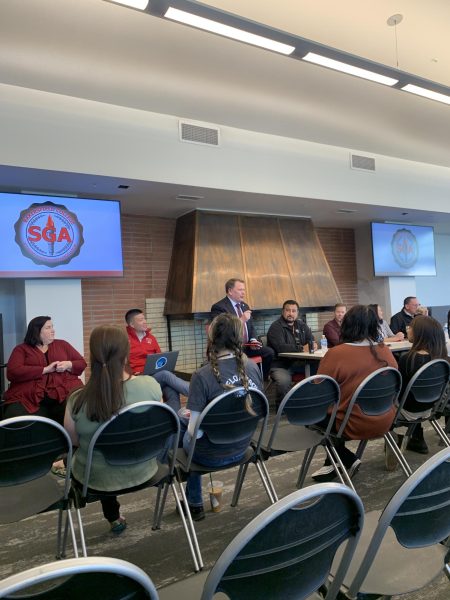The best way to deal with a Nazi is to socially exclude them
September 11, 2017
On Aug. 12, 2017 a rally titled “Unite the Right” was planned in Charlottesville, Virginia to protest the removal of a statue of Confederate general, Robert E. Lee. The rally, which was met with protests from a number of groups, including anti-hate groups and anti-fascist groups, ended with 19 injuries and the death of Heather Heyer, after the accused, James Alexander Fields Jr., is said to have driven a vehicle into a crowd of protesters.
After the incident, which many describe as a domestic terror attack, some on Twitter and other social media outlets began calling for the social ostracization and punishment of all racists and Neo-Nazis, including, but not limited to, punching them on sight.
Some say the rally shouldn’t have been allowed to happen at all. Others blame the counter-protesters for inciting violence. While some, including our president, say there’s blame on all sides.
There are many, including a number of my close friends, who unquestioningly agree with this call to action in the form of physically assaulting Nazis with a strategically placed fist to the face. There are also many, including a number of my other friends, who vehemently reject and denounce this call to action, and ultimately, violence.
I’ve listened to a battle between those who, while condemning the terrorist attack, site the first amendment’s guarantee to freedom of speech and assembly as a reason for as to why the Neo-Nazis were within their right to protest, and those who believe that the chanting of “blood and soil,” “Jews will not replace us,” and “white lives matter” by Neo-Nazis, while they marched with torches, is enough to be considered fighting words, and thus, not protected by the first amendment.
So the questions that I find absolutely necessary to tackle in this first edition of Beyond the Bias are: Where are the lines between free speech, hate speech, and “fighting words,” and at what point is it okay to respond to someone with physical violence?
Let’s start by differentiating between protected speech and unprotected speech.
Protected speech is clearly defined as free speech under the first amendment, and states that congress shall not impose a law which limits one’s ability to freely worship, speak, assemble, or petition the government for redress of grievances. It’s pretty clear cut. These basic freedoms, while vague, have been sited as the cornerstone of our society, and thus, worth discussing and debating … repeatedly.
There have been many Supreme Court cases that deal with the minute details of what constitutes free speech. According to the Supreme Court case of Texas vs. Johnson in 1989, “If there is a bedrock principle underlying the First Amendment, it is that the government may not prohibit the expression of an idea simply because society finds the idea itself offensive or disagreeable.” To be fair, this case dealt with whether or not the burning of the American flag should be considered offensive, but it begs the question: On principle, if flags are free to burn, are Nazis free to march?
This brings us to the subject of hate speech. If one simply searches for the definition of “hate speech” in the Merriam Webster online dictionary, they’ll be met with a definition of “speech expressing hatred of a particular group of people.” Few can deny that this definition is wholeheartedly vague. What if my hatred is directed towards people who dislike the 90s video game, The Legend of Dragoon, or those who have a distaste for tandoori chicken? Am I speaking hate speech when I say that I vehemently dislike those who can’t grasp an appreciation for late 90s RPGs and delicious, oven-baked chicken? Certainly not. Hate speech is reserved for situations when it is directed against groups that can be divided into categories such as race, age, religion, ability, and sexual identity or orientation. In other words, protected groups.
One is free to disagree with another person’s preference in video games and chicken, but not with whether or not another group should be allowed to exist. Especially when that categorization is dependent upon factors that one cannot choose; such as race, ability, or sexual orientation.
That leaves us with our third category of speech: fighting words. Fighting words are defined by Cornell University’s law website as, “Words which would likely make the person whom they are addressed commit an act of violence.” This issue was first addressed in 1942 in the case of Chaplinsky vs. New Hampshire, after a Jehovah’s Witness, Chaplinski, who was preaching on the streets referred to a peace officer as a fascist and racketeer. The peace officer and others in the crowd responded by physically assaulting Chaplinsky. It was ultimately found that those who attacked Chaplinksy were acting in self-defense, as Chaplinsky’s name calling was, in and of itself, an attack that would illicit a physical response from a reasonable person.
The fighting words defense has been covered in multiple different court cases in multiple different states. Each state has differing statutes on what constitutes fighting words, so punching a Nazi without legal repercussion is a shaky idea, at best.
Ultimately, the best solution for dealing with Nazis is complete and total social ostracization. Thus far, the continued shutting down of racist and white supremacist websites and online forums will be the most effective method of dealing with Nazis.








